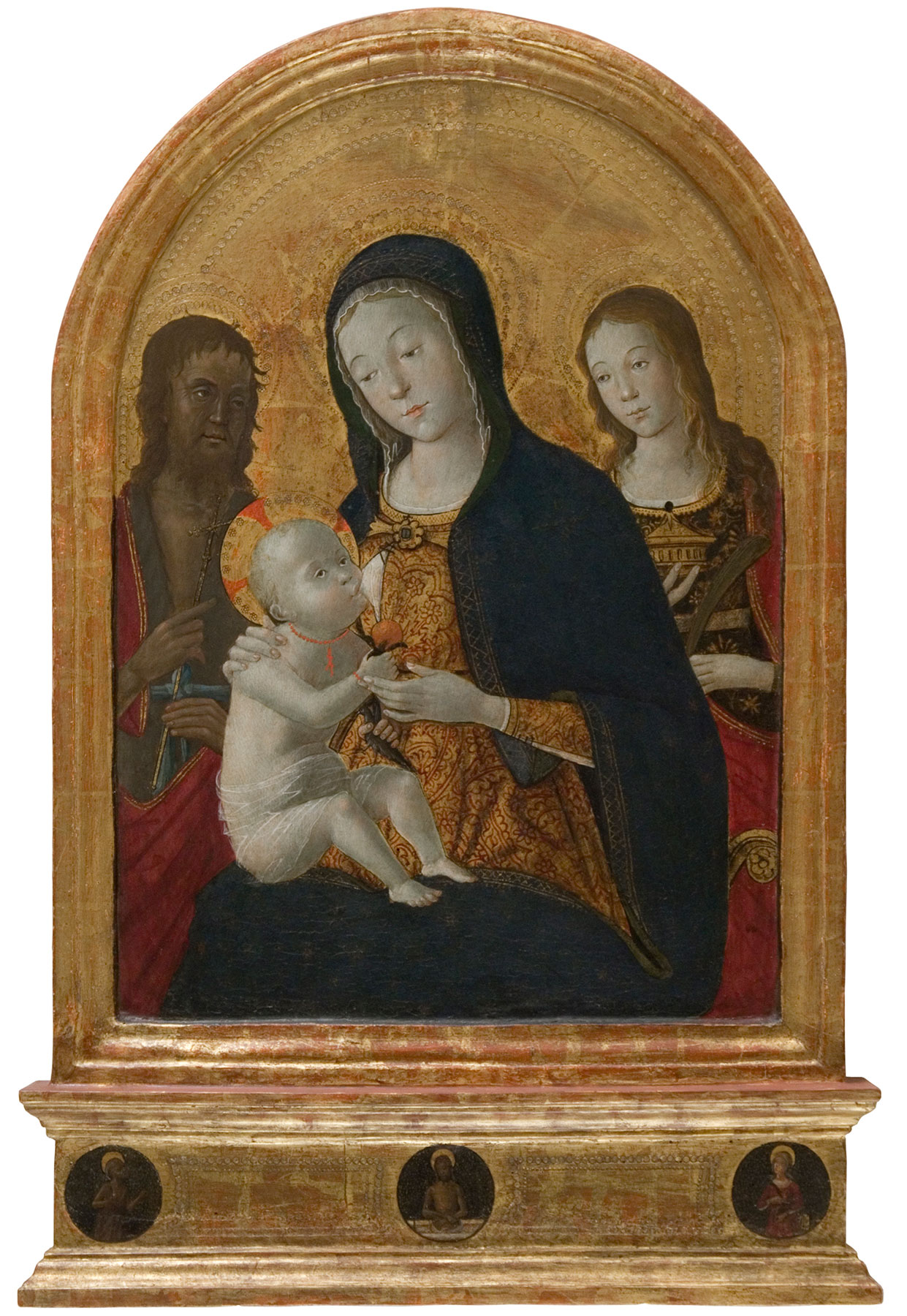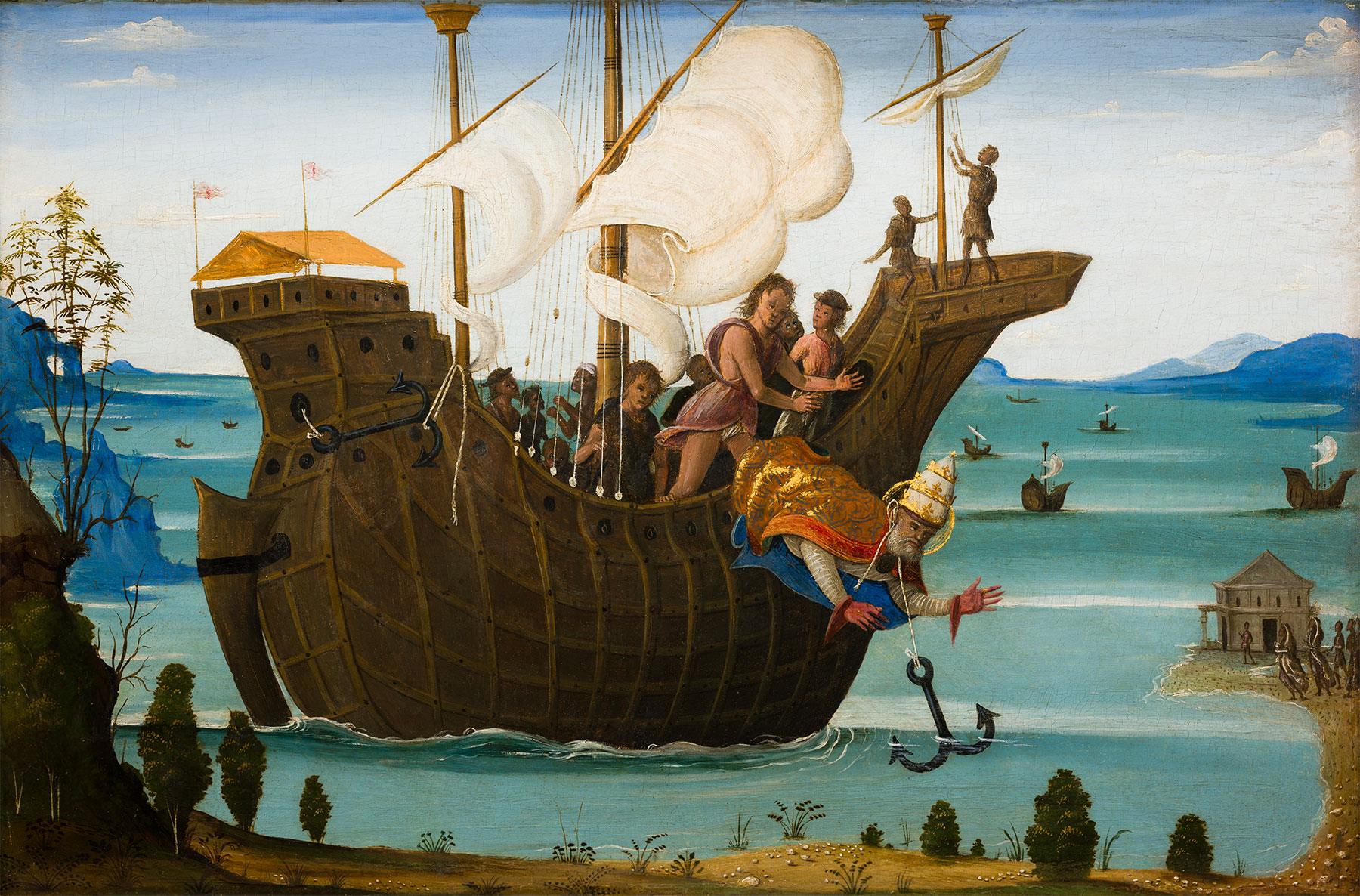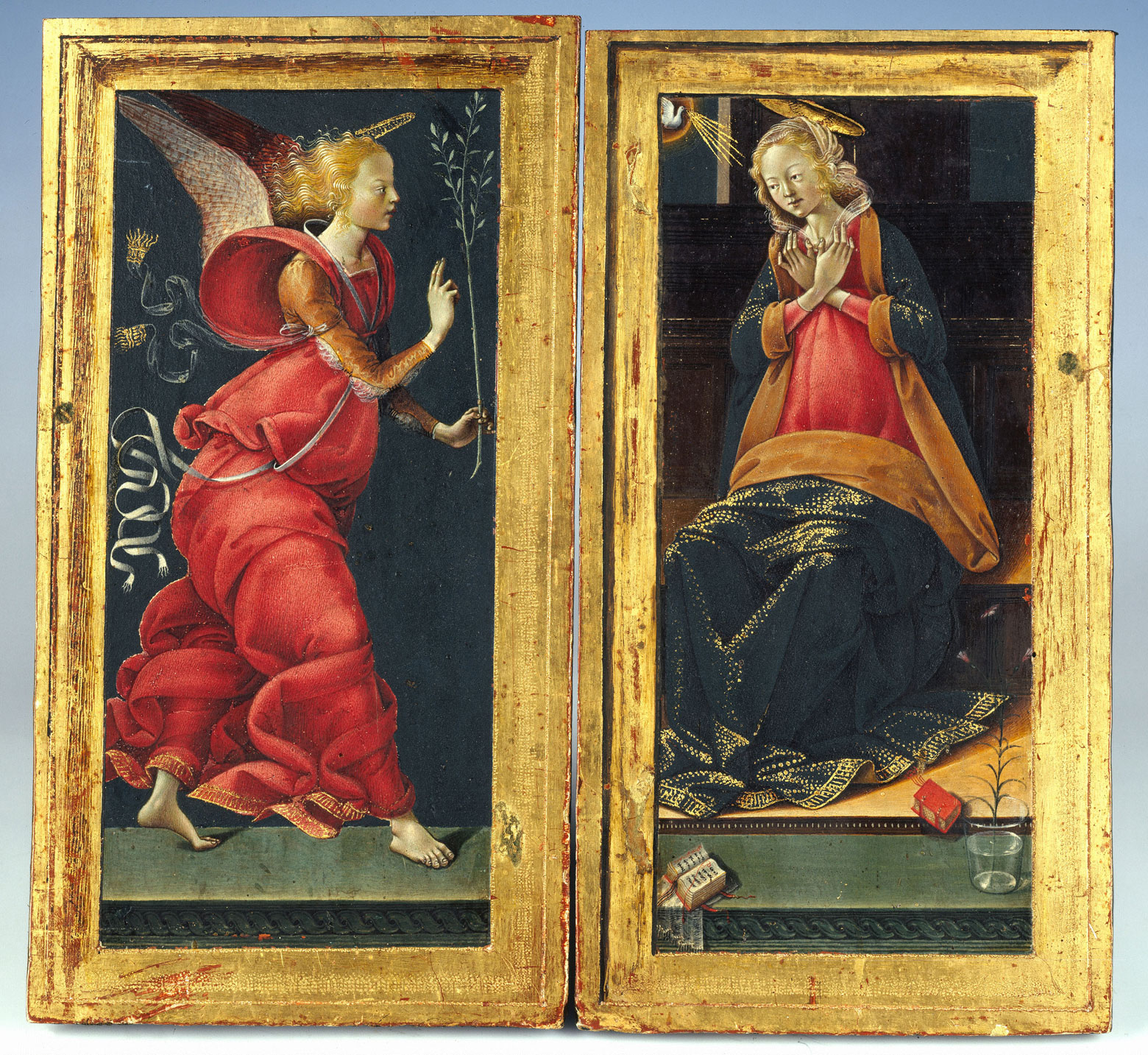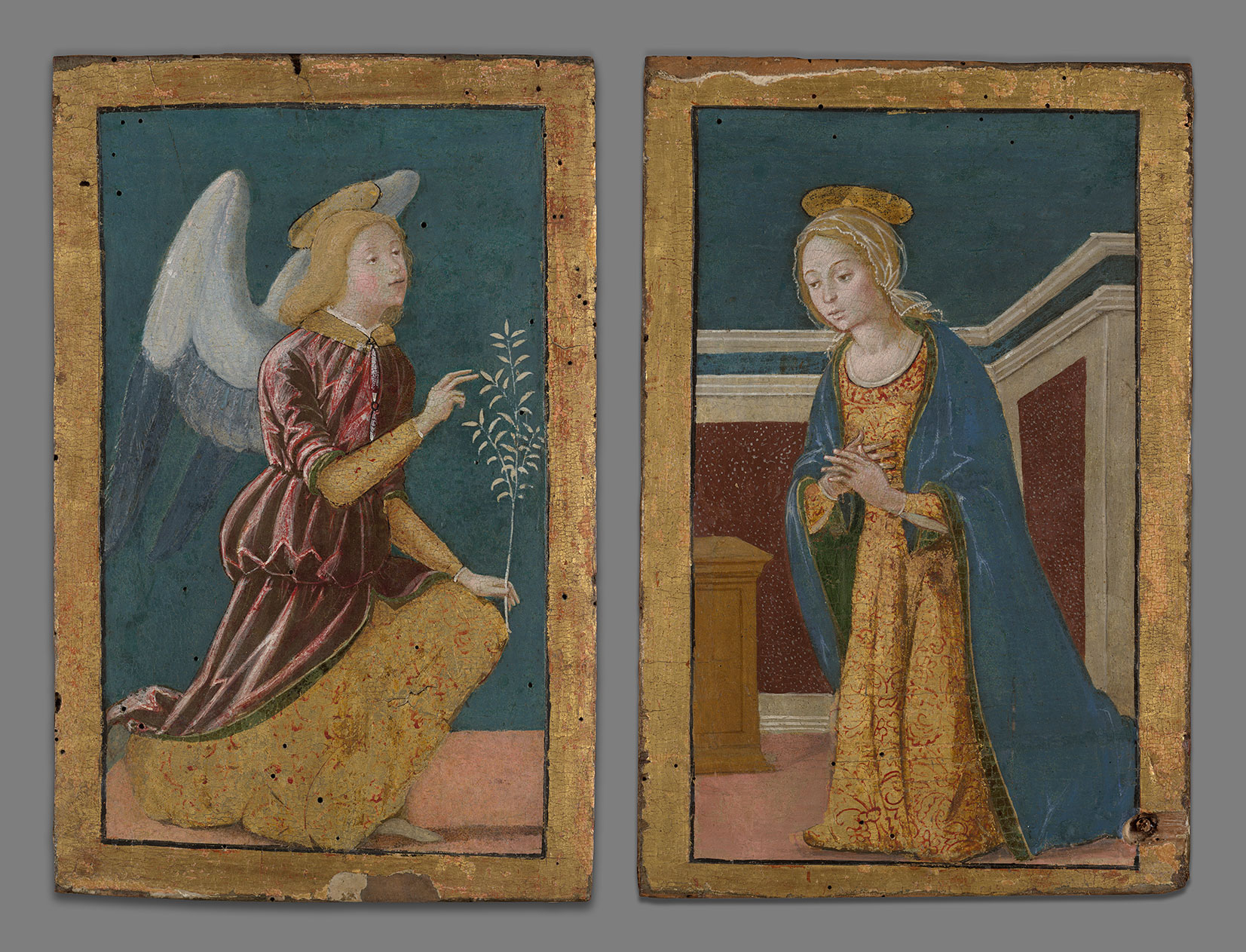View the Annunciatory Angel and the Virgin Annunciate in the Yale University Art Gallery’s online collection.
Art market, Paris, before 1924; Maitland Fuller Griggs (1872–1943), New York, 1924
The panel support of the Annunciatory Angel is walnut, of a vertical wood grain, and 2.0 centimeters thick. It has neither been thinned nor trimmed at left or right; a slight barb is visible at the edge of the gilded border on both the top and bottom. The gilding and paint surface have been moderately abraded, most recently during an aggressive cleaning by Andrew Petryn in 1966. Minor flaking losses were inpainted during a later treatment by Anne O’Connor in 2003, as were larger losses near the angel’s back foot at the lower left and in the gold margin at the bottom center.
The panel support of the Virgin Annunciate is poplar, of a horizontal wood grain, and 2.0 centimeters thick. It has neither been thinned nor trimmed at left or right; a slight barb is visible along the top edge only of the gilded border. A wooden dowel inserted front to back at the lower-right corner of the composition has been partially excavated and left exposed. A nail inserted front to back approximately in the center of the composition, 14 centimeters from the bottom edge, has been trimmed flush with the back of the panel. Its head is covered by a plug visible at the Virgin’s left breast. The gilding and paint surfaces have been moderately abraded, most recently during a cleaning by Petryn in 1968. Losses along a horizontal split 6 centimeters from the bottom, caused by a knot in the wood at the left edge, were repaired by Anne O’Connor during a treatment of 2003, as were losses to the gold draperies at the Virgin’s waist and to the wood of her lectern.
These two panels bore a generic attribution to the school of Verona when they were purchased by Maitland Griggs in Paris in 1924, but it appears that by 1926, he had been informed of their correct attribution to Bernardino Fungai.1 The source of this identification is not recorded, but many of the attributions Griggs received at that time came from Richard Offner. The panels were listed by Bernard Berenson in 1932 as works by Guidoccio Cozzarelli, but Raimond van Marle in 1937 corrected this to Fungai.2 The few subsequent notices they have garnered repeat the attribution to Fungai, except for Charles Seymour, Jr., who felt that “since the recent cleaning of both panels, the style emerges as one most likely to belong to a weak studio follower of Fungai in Siena, or possibly even that of a more provincial imitator.”3 It is impossible to imagine what points of comparison Seymour meant to adduce: although conventional lists of works by Fungai are cluttered with paintings by other Sienese and provincial Tuscan painters, few paintings are as solidly typical of his style and technique at the turn of the fifteenth century as these two panels. Both Everett Fahy and Carl Strehlke concurred with the attribution to Fungai,4 and it is, indeed, indisputable. The works to which they relate most closely are a tabernacle of the Virgin and Child with Saints John the Baptist and Mary Magdalen in the Pinacoteca Nazionale in Siena (fig. 1); four predella panels recounting episodes from the legend of Saint Clement divided between the City Art Gallery, York, England (fig. 2), and the Musée des Beaux-Arts, Strasbourg, France, which, together with a Man of Sorrows now also in York, were painted for the high altar of Santa Maria dei Servi in Siena;5 and the predella added by Fungai to the Tancredi altarpiece in the church of San Domenico, Siena.6 The last two are documented works of 1498–1501 and 1498–1505, respectively, providing a reasonable approximation of the likely date of the Yale Annunciation. A predella panel with the Annunciation in the Berenson Collection at Villa I Tatti, Settignano (fig. 3) is a slightly later work by Fungai and yet another confirmation of the accuracy of the attribution.7



The size and format of the Yale Annunciation panels suggest that they may have functioned as pilaster bases or impost blocks at the sides of an altarpiece, even though images of the Annunciation are not commonly encountered in those positions in Sienese structures. When the Annunciation appears in the frame of a Sienese altarpiece, it is often at the top of the lateral framing pilasters, as in examples by Pietro Orioli in the National Gallery, London,8 or Bernardino Fungai in the cathedral at Chiusi. The fact that the Yale panels are painted on two different kinds of wood with the grain running in opposite directions makes such a placement for them impossible. The Virgin retains evidence of having been attached to a surface behind it, as would have been the case with a projecting pilaster base, but if the Angel ever had such evidence, it must have been confined to the area underlying an engaged frame at the top and bottom that has been cut away from both panels. Two early panels by Fungai of four standing saints in the Pinacoteca Nazionale, Siena (see Bernardino Fungai, Virgin and Child, fig. 4), of a size and shape almost identical to those of the Yale panels, are commonly thought to have been fragments of a predella, but their vertical wood grain argues for a placement instead in the bases of framing pilasters. That position is usually reserved in late fifteenth-century Sienese altarpieces for display of the patrons’ coats of arms, but in a predella by Pietro di Francesco degli Orioli in the Siena Pinacoteca the projecting pilaster bases are filled with images of Saint Michael with Saint Cosmas on one side and Saint Raphael with Tobias and Saint Damian on the other (fig. 4). A nearly contemporary pair of panels by an artist probably from Volterra known as the Maestro dei Putti Bizzarri portrays the Annunciation (fig. 5) in a format similar to the two panels at Yale.9 The Volterra panels functioned as the wings of a folding triptych housing a reliquary embedded in its central panel, but as they are double-sided, with images of Saints Peter and Paul painted on the reverse, they are unlikely to provide a meaningful parallel for the original situation of the Yale Annunciation. —LK


Published References
Berenson, Bernard. Italian Pictures of the Renaissance: A List of the Principal Artists and Their Works with an Index of Places. Oxford: Clarendon, 1932., 158; van Marle, Raimond. The Development of the Italian Schools of Painting. Vol. 16. The Hague: M. Nijhoff, 1937., 467; Berenson, Bernard. Italian Pictures of the Renaissance, A List of the Principal Artists and Their Works with an Index of Places: Central Italian and North Italian Schools. 3 vols. London: Phaidon, 1968., 1:151; Seymour, Charles, Jr. Early Italian Paintings in the Yale University Art Gallery. New Haven: Yale University Art Gallery, 1970., 192–94, no. 145a; Fredericksen, Burton B., and Federico Zeri. Census of Pre-Nineteenth-Century Italian Paintings in North American Public Collections. Cambridge, Mass.: Harvard University Press, 1972., 600
Notes
-
Frick Art Reference Library, New York. ↩︎
-
Berenson, Bernard. Italian Pictures of the Renaissance: A List of the Principal Artists and Their Works with an Index of Places. Oxford: Clarendon, 1932., 158; and van Marle, Raimond. The Development of the Italian Schools of Painting. Vol. 16. The Hague: M. Nijhoff, 1937., 467. ↩︎
-
Seymour, Charles, Jr. Early Italian Paintings in the Yale University Art Gallery. New Haven: Yale University Art Gallery, 1970., 194. ↩︎
-
Manuscript opinions, ca. 1998, curatorial files, Department of European Art, Yale University Art Gallery. ↩︎
-
Laurence Kanter, in Christiansen, Keith, Laurence Kanter, and Carl Brandon Strehlke. Painting in Renaissance Siena, 1420–1500. Exh. cat. New York: Metropolitan Museum of Art, 1988., 353–58. The center panel of the predella, whose whereabouts were unknown in 1988, was subsequently acquired by the York City Art Gallery; inv. no. 1455, https://www.yorkmuseumstrust.org.uk/collections/search/item/?id=20000201. The Servi altarpiece was executed between April 1488 and September 1501. ↩︎
-
Marcella Parisi, in Bellosi, Luciano, ed. Francesco di Giorgio e il Rinascimento a Siena, 1450–1500. Exh. cat. Milan: Electa, 1993. , 482–85. ↩︎
-
Dóra Sallay, in Strehlke, Carl Brandon, and Machtelt Brüggen Israëls, eds. The Bernard and Mary Berenson Collection of European Paintings at I Tatti. Milan: Officina Libraria, 2015., 273–78. Sallay dates this work 1500–1505; the end of that range seems more likely than the beginning. ↩︎
-
Inv. nos. 1849.1–.2, https://www.nationalgallery.org.uk/paintings/pietro-orioli-the-nativity-with-saints-altarpiece. ↩︎
-
Alessandro Angelini, in Bellosi, Luciano, ed. Francesco di Giorgio e il Rinascimento a Siena, 1450–1500. Exh. cat. Milan: Electa, 1993. , 430–33. ↩︎
